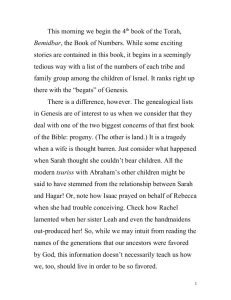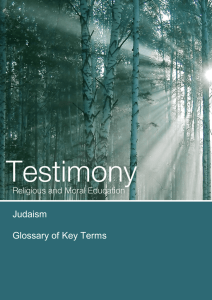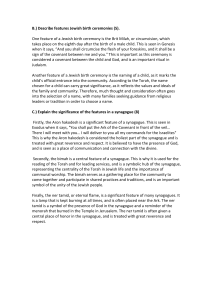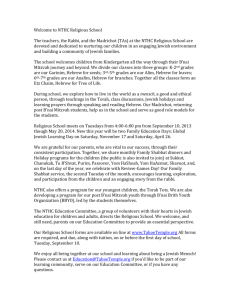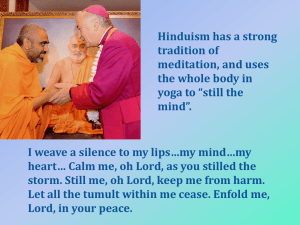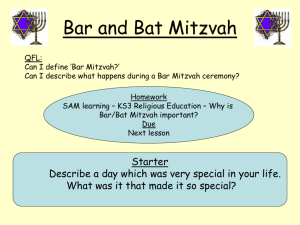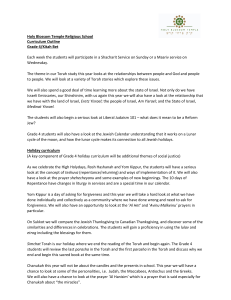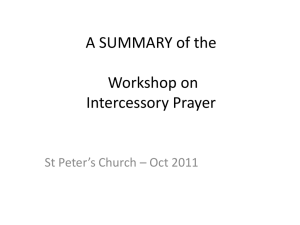Jewish Practices and Symbols Presentation
advertisement
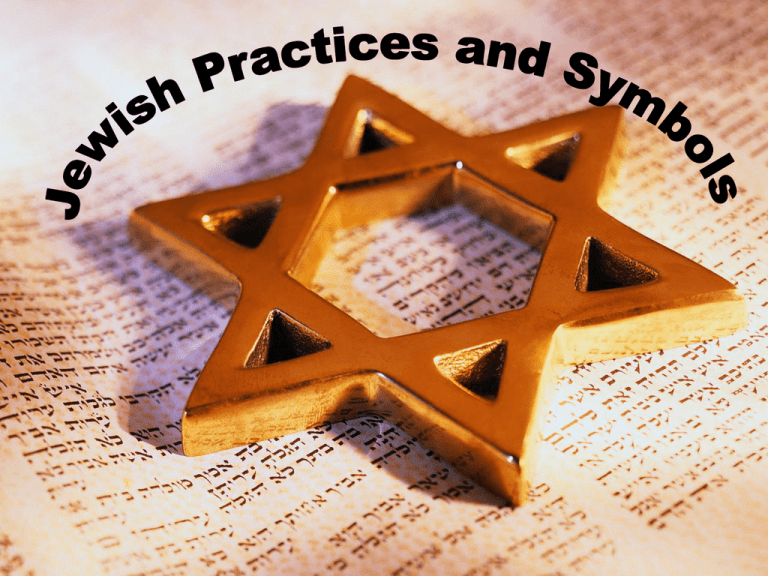
Observer of the Commandment • Judaism focuses on how to worship God • It could be said that for Jews, spiritual perfection is mainly a matter of perfect observance • Observing Torah requires not only worshiping God but also leading an ethical life. Daily worship through prayer • Prayer worship is mandatory only for males age 13 and older • Women are traditionally excused because of their household responsibilities • Males alone are required to wear certain ritual accessories – Skullcap aka yarmulke- God is higher than humans – Tefillin- A set of 2 small boxes containing biblical passages secured to the forehead and to the left arm – near the mind and the heart – The Talit or prayer shawl- can be drawn over the head for privacy. And it signifies humility in the sight of God • Prayers are said 3 times a day – Morning, afternoon, and evening – Prayers are usually recited at home but in public synagogues as well • Home and synagogue are the two centers of Jewish worship Rites of Passage • • Ritual events marking life’s major changes 2 purposes 1. Reflect the inevitable changes of life 2. Define the responsibilities of each stage of life Birth and Naming • The rite of passage marking the birth of a child involves circumcision for boys, and naming for both boys and girls • Boys are circumcised and named in a ceremony that takes place on the 8th day of life – The ceremony takes place in the house of the parents • girls are named at the synagogue during a Sabbath service Coming of Age • Bar mitzvah = son of the commandment – Boys read from the Torah • Bat mitzvah = daughter of the commandment – Girls also read from the Torah – Orthodox Jewish girls do not observe bat mitzvah • The coming of age is the rituals in which boys and girls take on the religious responsibilities of an adult Marriage • The bride and groom stand beneath the huppah or bridal canopy • Seven blessing are read over a cup of wine • The ceremony concludes when the groom breaks a wine glass beneath his foot – Ancient tradition- symbol of the destruction of the two Temples in Jerusalem – It reminds the married couple that marriage brings difficulties and pain along with joy Death and mourning • Several distinct stages of mourning are prescribed: Stage 1: Lasts from death to burial • • • • Family members rip their clothes and recite verse when they find out that a family member died The mourners are restricted from certain activities- shaving and wearing leather They are relieved of many of the normal requirements- daily prayer The deceased is buried in a plain wooden coffin Death and mourning- stage 2 • The second stage begins after burial with the recital of the kaddish – A prayer of mourning • This stage lasts for seven days • During this time community members visit the family • Conversation is limited to good comments about the one who has died • Upon departing, the visitors recite a special prayer of comfort Death and mourning- stages 3 & 4 • • • • A third stage lasts until 30 days after burial Normal activities are resumed But social gathering and celebrations are avoided A fourth stage follows if the deceased is one’s parent – It lasts until the first anniversary of the death – The mourners avoid their usual seats at the synagogue – Recite the kaddish during services and on the anniversary of the death Jewish Symbol: the Mezuza • Attached to the right of the door to people’s homes on the outside • Contains a scroll with the Shema Jewish Symbols: Shofar • Shofar – Represents call to action – Recalls: • The act of creation • The sound of trumpets on Mt. Sinai • Joshua at the battle of Jericho – Used on Yom Kippur to call people to repentance – Used on Rosh Hashanah to readiness for a new year Jewish symbols: Menorah • Menorah – Celebrates the miracle of the oil lamp that lasted 7 days longer than expected • occurred at the rededication of the Temple in Jerusalem after the Greeks had defiled it Kosher • Means ritually correct • Applies to food preparation and consumption • All blood is sacred to God • It gives life • Pork and shellfish are forbidden
